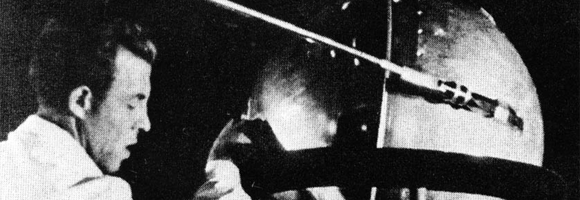spooknik

On 4 October 1957 ↑Stephen King was at the cinema. Together with the other ten-year-olds clustered around him he watched the morning performance of ↑Earth vs. the Flying Saucers. Just as the flying saucers started their attack on Washington D.C. the movie was interrupted and the houselights went on. Pale and nervous the manager entered the auditorium. “‘I want to tell you’, he said in that trembly voice, ‘that the Russians have put a space satellite into orbit around the earth. They call it … Spootnik.'” (↵King 1993[1981]:21) For the assembled post-war kids a world crashed. The world of US-American supremacy and absolute security. (↵Chace & Carr 1988) There was complete silence in the cinema. Within this silence everybody realized that far above their heads there was an electronic tin-ball cruising through space, beeping triumphantly. And this tin-ball had been invented, constructed, and built beyond the Iron Curtain. In the race for space the Russians had beaten the American pioneer-spirit.

In 1957 the abbreviation ICBM (Intercontinental Ballistic Missile) already had found its way into public discussion. The American understanding of those four letters went like this: If the Soviets would undertake something audacious, rockets would instantaneously carry the nuclear death to Moscow. This recourse flew in pieces on 4 October 1957, too: “After all, ICBMs were only big rockets, and the Commies hadn’t lofted ↑Sputnik I into orbit with a potato masher.” (↵King 1993[1981])
In order to regain military-technological supremacy, to regain security, the US-ministry of defence founded the Advanced Research Projects Agency (ARPA) in 1958. The idea behind ARPA was to mobilize and fuse research-ressources—especially those of the universities. One mistake should by no means be repeated: To lose ground because of the own hybris and torpidness. So it was carefully avoided to lay aside or miss any chance—may it appear ever so small on first glance. In consequence many small projects flourished at ARPA which would have quickly died away everywhere else due to negligence. But at ARPA it was not only possible to securely work on projects of that ilk, but there was the chance to gain access to substantial ressources.
A key to the rapid growth of the Internet has been the free and open access to the basic documents, especially the specifications of the protocols. The beginnings of the ARPANET and the Internet in the university research community promoted the academic tradition of open publication of ideas and results. (↵Leiner et al. 2003, compare ↵Kelty 2001)
The Internet is as much a collection of communities as a collection of technologies, and its success is largely attributable to both satisfying basic community needs as well as utilizing the community in an effective way to push the infrastructure forward. (↵Leiner et al. 2003)

